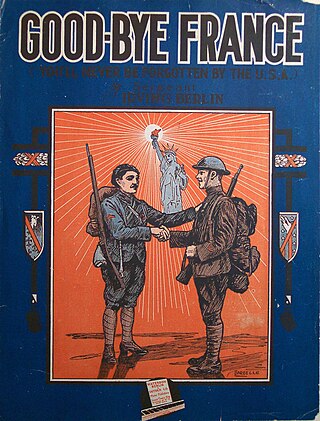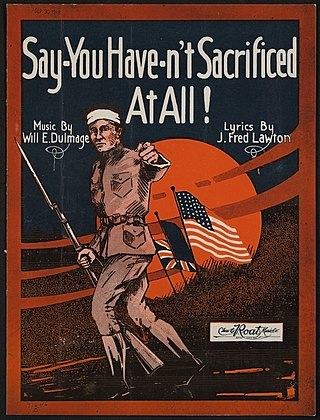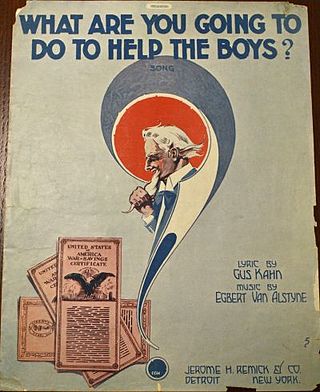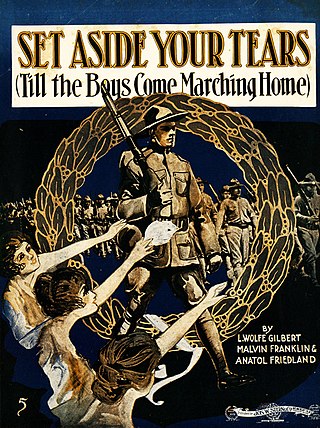
"Tell that to the Marines" is a 1918 song, written during World War I. Jean Schwartz and Al Jolson composed the music; Harold Atteridge wrote the lyrics. Al Jolson performed an early version of the song. Based on sales estimates, it reached number two on the Top 100 US songs of its time.

"Joan of Arc, They Are Calling You" is a 1917 song composed by Jack Wells, and with lyrics written by Al Bryan and Willie Weston. It appeared in the contemporary musical production, This Way Out.

Goodbye, France or "Good-bye France " is a World War I era song written and composed by Irving Berlin and published by Waterson, Berlin & Snyder, Inc., in New York City. The sheet music cover, illustrated by Albert Wilfred Barbelle, features French and American soldiers shaking hands with the Statue of Liberty in the background.

"The Worst Is Yet to Come" is a World War I-era song recorded on December 12, 1918 in Camden, New Jersey. Sam M. Lewis and Joe Young provided the lyrics. Bert Grant was the composer. The song was published by Waterson, Berlin & Snyder, Inc. in New York City. Billy Murray performed the song. Artist Albert Wilfred Barbelle designed the cover art for the sheet music. On one version of the cover, a soldier is in position to bayonet a prisoner in bed.

"Say, You Haven't Sacrificed at All! (March)", also written as "Say-You Haven't Sacrificed at All!" or "Say-You Have-n't Sacrificed at All!", is a World War I era song released in 1918. Most sources have attributed the role of composer to Will E. Dulmage and lyricist to J. Fred Lawton, as it is credited on the sheet music cover. One source has their roles reversed, and another source claims both composed the music. The song was published by Chas E. Roat Music Co. of Battle Creek, Michigan. On the cover is a soldier with a head wound, pointing. Behind him are British, French, and American flags. It was written for both voice and piano.

"We Don't Want the Bacon (What We Want Is a Piece of the Rhine)" is a World War I–era song released in 1918. The lyrics were written by "Kid" Howard Carr and Harry Russell, and the music composed by Jimmie Havens. The song was published by Shapiro, Bernstein & Co. of New York City. On the cover is a soldier tearing through a large piece of bacon with his bayonet. A fearful-looking Kaiser Wilhelm II is standing on the bacon. It was written for voice and piano.

"When the 'Yanks' Come Marching Home" is a World War I era song released in 1917. William Jerome wrote the lyrics. Seymour Furth composed the music. It was published by A.J. Stansy Music Co. of New York City.

"What Are You Going to Do to Help the Boys?" is a World War I era song released in 1918. Gus Kahn wrote the lyrics. Egbert Van Alstyne composed the music. It was published by Jerome H. Remick & Co. of Detroit, Michigan. Artist E.E. Walton designed the sheet music cover. It features Uncle Sam inside a red, white, and blue question mark. He is holding his beard and looking down at liberty bonds. To the left of this image it reads, "Buy a Liberty Bond!" on some editions. The song was written for both piano and voice.

"Somewhere in France Is Daddy" is a World War I era song released in 1917. Lyrics and music were written by "Great Howard," otherwise known as Howard Miller. It was published by Howard & LaVar Music Co. of New York, New York. There are two versions of the sheet music cover. Both feature a mother holding a child, soldiers firing from a trench, and an inset photo of Great Howard. The latter version is a darker blue and the photo is of Howard in kilts. The song was written for both voice and piano.

"It's a Long Way to Berlin, but We'll Get There!" is a World War I era song released in 1917. Arthur Fields wrote the lyrics. Leon Flatow composed the music. Leo Feist, Inc. of New York City published the song. Rosenbaum Studios designed the sheet music cover. It features soldiers marching in formation. There is an inset photo of Maurice Burkhardt, Will J. Ward, Ed Morton, Jimmy Flynn, Willie Weston, or Francis Maguire that varies per edition. There is another version of the cover known as the "Popular edition". It features a photo of Henry Bergman.

"The Ragtime Soldier Man" is a World War I era song released in 1912 and 1917. Irving Berlin wrote the lyrics and composed the music, basing it off his 1911 song "Alexander's Ragtime Band". The song was published by Waterson, Berlin & Snyder, Co. of New York, New York. Artist Pfeiffer designed the sheet music cover. It features a U.S. soldier holding his rifle and jumping over cannon balls. The song was written for voice and piano.

"For Your Country and My Country" is a World War I era song released in 1917. Lyrics and music were written by Irving Berlin. The song was published by Waterson, Berlin & Snyder, Co. of New York, New York. Artist Albert Wilfred Barbelle designed the sheet music cover. It features Uncle Sam playing a snare drum with an eagle on his shoulder. In the background are ships sailing, and below are troops marching. Above the title, it reads, "The Official Recruiting Song." The song was written for voice and piano, along with chords for guitar, ukulele, and banjo.
"Hock The Kaiser!" is a World War I song written and composed by James H. Hall in 1917. It targets the German emperor Wilhelm II of Germany. The work was self-published by James H. Hall in Chicago, Illinois.

Set Aside Your Tears (Till the Boys Come Marching Home) is a World War I song written and composed by Wolfe Gilbert, Malvin Franklin, and Anatole Friedland. The song was first published in 1917 by Jos. W. Stern & Co. in New York, NY. The sheet music cover depicts a woman waving to marching troops.
We'll Carry The Star Spangled Banner Thru The Trenches is a World War I song written by Daisy May Pratt Erd. The song was first published in 1917 by Lang & Mendelsohn in Boston MA. The sheet music cover depicts soldiers advancing over barbed wire with a flag waving.

Let's All Be Americans Now is a World War I song written and composed by Irving Berlin, Edgar Leslie, and George W. Meyer. The song was first published in 1917 by Waterson, Berlin & Snyder Co., in New York, NY, appearing in the Broadway musical, 'Dance and Grow Thin'. The sheet music cover depicts a soldier with his rifle and silhouetted marching soldiers in the background. A popular recording in 1917 was made by the American Quartet.

"The Russians Were Rushin', the Yanks Started Yankin'" is a World War I song written by Carey Morgan and composed by Charles R. McCarron. The song was first published in 1918 by Broadway Music Corporation in New York City. The sheet music cover depicts an elderly man smoking a pipe with silhouetted soldiers across the top and bottom.
We'll Knock The Heligo—Into Heligo—Out Of Heligoland! is a World War I song written by John J. O'Brien and composed by Theodore Morse. The song was first published in 1917 by Leo Feist Inc., in New York, NY. The sheet music cover depicts a terrified Kaiser Wilhelm II standing on top of Heligoland while shells are bursting in his back and United States sailors with guns are rushing toward him.
"What'll We Do with Him Boys? " is a World War I song written by Andrew B. Sterling and composed by Arthur Lange. The song was first published in 1918 by Joe Morris Music Co., in New York City. The sheet music cover depicts a jungle scene with a monkey and a lion with an inset photo of W. J. Reilly.
You Keep Sending 'Em Over and We'll Keep Knocking 'Em Down is a World War I song written by Sidney D. Mitchell and composed by Harry Ruby. The song was first published in 1917 by Waterson, Berlin & Snyder Co., in New York, NY. The sheet music cover depicts a soldier on top of a trench ladder uses his rifle as a club with an inset photo of Eddie Cantor.















